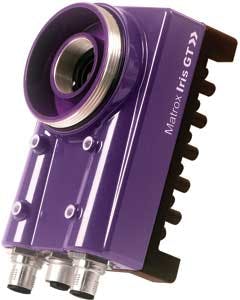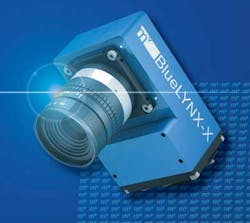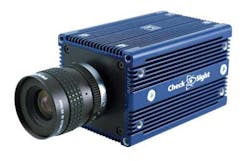Faster, Smarter Camera Deployment
Andrew Wilson, Editor
Because of the relatively long learning curve associated with new software packages, system developers often become tied to a specific manufacturer when developing their new or next-generation machine-vision systems. This is understandable, but it can limit the choice of hardware offered by the software integrator.
A system integrator familiar with one software package may wish to use the software in a new system, but may find that the software provider does not support a specific frame grabber for an HD-SDI camera, for example. Because no one company will probably ever offer a range of products that supports every type of camera interface, some engineering work may then be required to find an alternative vendor that can provide support for the software package the developer wishes to deploy.
Hardware and software
A number of smart camera companies are teaming with well-known software providers such asCognex, MVTec, National Instruments, Stemmer Imaging, and Tordivel to allow multiple image-processing and machine-vision packages to run on their smart cameras. By doing so, these smart camera vendors allow system developers to choose from a range of software packages and smart camera hardware, alleviating the need for the developer to learn new software.
Some smart camera vendors only offer their products with their own machine-vision software.PPT Vision’s Impact Vision Program Manager is an icon-based program that allows developers access to approximately 120 tools for functions such as measurement, optical character recognition, pattern matching, and blob analysis. Operating with PPT Vision’s smart cameras and machine-vision systems, the Impact Vision Program Manager can be used in conjunction with the company’s Control Panel Manager (CPM) to let developers create custom control panels for their machine-vision systems.
Although PPT only supports its software package on its own smart cameras, other companies have taken a different approach. Well-known machine-vision and image-processing packages such asMatrox Imaging Library (MIL), NI’s Vision Builder for Automated Inspection, and Cognex’s VisionPro have all been offered for a number of years on PC-based systems; now they can be used in conjunction with smart cameras offered by these respective companies.
Matrox’s Iris GT smart camera offers a PC-like environment for developing applications using standard Windows tools in conjunction with MIL, a software development kit for image capture, processing, analysis, annotation, display, and archiving (see Fig. 1). MIL supports Matrox’s Iris GT smart camera, as well as being available to third-party developers of smart cameras such asSony.
Like Matrox,Microscan’s Visonscape machine-vision software offers tools for image analysis, OCR and OCV, and reading and verifying barcodes. Using Microscan’s FrontRunner interface, vision applications can be created and run either on PC-based systems or downloaded to the company’s Visionscape smart camera. Ximea also plans to support VisionScape on its recently introduced Currera-R Series of products. Likewise, both NI’s LabVIEW and Cognex’s VisionPro can be used in conjunction with third-party smart cameras. By offering their software on their own and third-party smart cameras, companies such as Matrox, NI, and Cognex ensure that their software gains wider market acceptance.
Yours and mine
Other smart camera vendors have taken yet another tack with software support, allowing developers to use software engineered by the smart camera vendors themselves as well as third-party software. Offering support for its mvIMPACT series of image-processing tools,Matrix Vision also supports established software packages such as VisionPro, Halcon, and Neurocheck in its range of 1-GHz ARM-based mvBlueLYNX-X series of cameras (see Fig. 2).
Supporting their in-house tools as well as third-party software allows vendors like Matrix Vision to gain a wider market for their products by allowing developers to choose their favorite image-processing and machine-vision packages. This has also led to the introduction of PC-based smart cameras developed by companies that leverage the power of third-party software support, although they do not offer their own machine-vision or image-processing software. To gain maximum market share, many of these companies have chosen just to support the most popular software packages.
In the development of its XCI-100 Series of smart cameras Sony has chosen to support third-party-based software packages including NI’s Vision Builder AI, an interactive menu-driven application that performs more than 100 machine-vision tasks such as geometric pattern matching, OCR, and particle analysis. Because the camera series is PC-based, it can support other third-party software packages such as Halcon from MVTec, Matrox’s MIL, and Sapera fromTeledyne DALSA.
Like Sony,Leutron Vision also supports a number of third-party software packages in its 1.6-GHz Intel Atom-based CheckSight smart camera series (see Fig. 3). By developing a GenICam/GenTL-compliant smart camera series, the company enables the cameras to be used with image-processing libraries that support the Generic Transport Layer (GenTL) of the GenICam standard, such as Halcon, Stemmer Imaging’s Common Vision Blox, MIL, LabVIEW and VisionPro. By implementing the same hardware architecture across a number of different models, the company offers a range of CMOS- and CCD-based versions of the camera with imagers ranging from VGA to 5-Mpixel resolution.
Software support
The introduction of PC-based smart cameras has both reduced the cost of implementing image-processing and machine-vision systems and opened up new avenues for less well-known software vendors to offer their products. Companies with relatively small marketing budgets can align themselves with smart camera hardware vendors to maximize the potential sales of their products. Perhaps nowhere is this trend more apparent than at Ximea, a smart camera company that currently offers support for more than ten of the best-known image-processing and machine-vision packages.
Founded as a partnership between Softhard and Delaro, Ximea premiered its smart camera, the Currera-R Series, at VISION 2010 in Stuttgart. The Intel Atom-based smart camera is offered with various different imagers ranging from WVGA to 5 Mpixels (see Fig. 4). The camera is offered with APIs that include support for GenTL, but the company is not yet offering its own image-processing or machine-vision software. Rather, the camera supports eight third-party machine-vision libraries including LabVIEW, Common Vision Blox, and Tordivel’s Scorpion packages.
Interestingly, the company has plans to support a range of less well-known, more specialized software packages. Many of the vendors of these image-processing packages offer free trial versions or free versions for noncommercial use that can be downloaded from their web sites. Since many of these software packages are Windows-based, developers can evaluate the software before purchasing or embedding a final version in a smart camera. Options includeAdaptive Vision Studio 2.0, a graphical program from Adaptive Vision that allows developers to build vision algorithms using a library of more than 400 built-in computer vision filters. For image classification, segmentation, and recognition, Ximea also has plans to support Pinta from Intopii as well as more general-purpose image-processing packages such as SmartVision from ATS Automation.
While Ximea’s philosophy of supporting multiple software packages is a growing trend among smart camera vendors, it remains to be seen how widespread the approach will be. On one hand, offering support for multiple software packages will certainly broaden the acceptance of smart cameras. Although feasible, providing software support for multiple software tools may prove more difficult for less well-known smart camera vendors. For independent software vendors, however, the trend by smart camera companies to support multiple software packages will certainly be beneficial.
Company Info
Adaptive Vision
Gliwice, Poland
Leutron Vision
Glattbrugg, Switzerland
Matrix Vision
Oppenweiler, Germany
Matrox Imaging
Dorval, QC, Canada
MVTec Software
Munich, Germany
National Instruments
Austin, TX, USA
PPT Vision
Bloomington, MN, USA
Softhard
Marianka, Slovak Republic
Sony Visual Imaging Products
Park Ridge, NJ, USA
Stemmer Imaging
Puchheim, Germany
Teledyne DALSA
Waterloo, ON, Canada
Vision Systems Articles Archives





